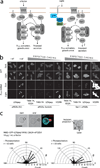TULIPs: tunable, light-controlled interacting protein tags for cell biology
- PMID: 22388287
- PMCID: PMC3444151
- DOI: 10.1038/nmeth.1904
TULIPs: tunable, light-controlled interacting protein tags for cell biology
Abstract
Naturally photoswitchable proteins offer a means of directly manipulating the formation of protein complexes that drive a diversity of cellular processes. We developed tunable light-inducible dimerization tags (TULIPs) based on a synthetic interaction between the LOV2 domain of Avena sativa phototropin 1 (AsLOV2) and an engineered PDZ domain (ePDZ). TULIPs can recruit proteins to diverse structures in living yeast and mammalian cells, either globally or with precise spatial control using a steerable laser. The equilibrium binding and kinetic parameters of the interaction are tunable by mutation, making TULIPs readily adaptable to signaling pathways with varying sensitivities and response times. We demonstrate the utility of TULIPs by conferring light sensitivity to functionally distinct components of the yeast mating pathway and by directing the site of cell polarization.
Figures



References
Publication types
MeSH terms
Substances
Grants and funding
LinkOut - more resources
Full Text Sources
Other Literature Sources
Molecular Biology Databases
Research Materials

